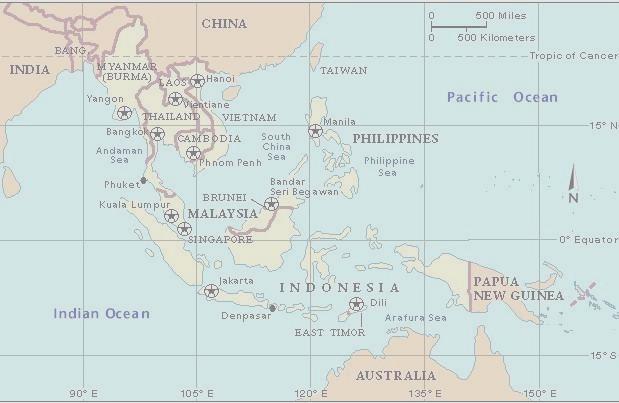


Southeast Asia, region of Asia comprising the Indochinese and Malay peninsulas and several nearby island groups. The region is bordered on the north by China; on the east by the South Pacific Ocean; on the south by the Indian Ocean; and on the west by the Indian Ocean, the Bay of Bengal, and the Indian subcontinent. Southeast Asia includes the countries of Brunei, Myanmar (formerly known as Burma), Cambodia (Kâmpuchéa), Indonesia, Laos, Malaysia, the Philippines, Singapore, Thailand, and Vietnam.
INTRODUCTION:
Before World War II there was no term for the part of Asia that is located south of China and east of India. During the war, when the region assumed great strategic importance, the term Southeast Asia was adopted to describe this region, which came to encompass the ten independent nations of Brunei, Myanmar (Burma), Cambodia, Indonesia, Laos, Malaysia, the Philippines, Singapore, Thailand, and Vietnam, with East Timor joining the list in May 2002. Except for Thailand (formerly Siam), which was never colonized by Europeans, all of these nations gained their independence after World War II. Although they are collectively referred to as Southeast Asia, it is impossible to generalize about them other than to comment on their similar geography. Southeast Asians practice animism, Islam, Buddhism, Roman Catholicism, and a variety of other religions, and they speak hundreds of languages. Diversity is a more important attribute of Southeast Asia than is homogeneity. Another reason it is difficult to generalize about Southeast Asia is because it is changing so rapidly. Just a few decades ago the region was rural, impoverished, and isolated. Today it is increasingly urban, with rising income levels, massive traffic jams in huge cities, vibrant capitalist economies interconnected with the rest of the world, and pervasive telephone, television, and automobile communications. The days when it was a little-known region of poor and isolated villages have passed.
| Papyrus Scroll Before paper was invented, many people wrote on scrolls made out of the papyrus plant. By layering, wetting, and then drying layers of the plant’s cellulose together, people could create a fine writing surface. This hieroglyphic scroll is part of the Book of the Dead, from ancient Egypt. Its detailed illustrations demonstrate both the durability and quality of papyrus. |
Alphabet (from alpha and beta, the first two letters of the Greek alphabet), set of written symbols, each representing a given sound or sounds, which can be variously combined to form all the words of a language
An alphabet attempts ideally to indicate each separate sound by a separate symbol, although this end is seldom attained, except in the Korean alphabet (the most perfect phonetic system known) and, to a lesser degree, in the Japanese syllabaries. Alphabets are distinguished from syllabaries and from pictographic and ideographic systems. A syllabary represents each separate syllable (usually a sequence of from one to four spoken sounds pronounced as an uninterrupted unit) by a single symbol. Japanese, for example, has two complete syllabaries—the hiragana and the katakana—devised to supplement the characters originally taken over from Chinese. A pictographic system represents picturable objects, for example, a drawing of the sun stands for the spoken word sun. An ideographic system combines various pictographs for the purpose of indicating nonpicturable ideas. Thus, the Chinese pictographs for sun and tree are combined to represent the Chinese spoken word for east.
Early systems of writing were of the pictographic-ideographic variety; among them are the cuneiform of the ancient Babylonians and Assyrians, Egyptian hieroglyphs, the written symbols still used by the Chinese and Japanese (see Chinese Language; Japanese Language), and Mayan picture writing (see Native American Languages; Maya). What converts such a system into an alphabet or syllabary is the use of a pictograph or ideograph to represent a sound rather than an object or an idea. The sound is usually the initial sound of the spoken word denoted by the original pictograph. Thus, in early Semitic, a pictograph representing a house, for which the Semitic spoken word was beth, eventually came to symbolize the initial b sound of beth. This Semitic symbol, standing originally for the entire word beth and later for the sound of b, ultimately became the b of the English alphabet.
GEOGRAPHY:Southeast Asia comprises two main geographic regions: mainland and island. Mainland Southeast Asia consists of Cambodia, Laos, Myanmar, Thailand, and Vietnam. All of these nations are closely connectedÑthrough history, traditions, and tradeÑwith China and India. Island Southeast Asia consists of tiny Brunei, on the northern coast of the huge island of Borneo; Indonesia; Malaysia; the Philippines; the city-state of Singapore; and East Timor, located on the eastern half of the island of Timor.
The rivers and mountains of Southeast Asia generally run north-south and have been important in separating the many ethnic groups living in the region. Rivers are the most significant geographic features of Southeast Asia, as they determined the forms and patterns of settlement and agriculture. The Mekong River is the largest and most important of Southeast Asia's rivers, flowing through all the countries of mainland Southeast Asia and providing much of the irrigation needed to grow crops. A major feature of the Mekong is its connection to Southeast Asia's largest lake, the Tonle Sap, which is located in northern Cambodia. Because the Tonle Sap River, which links the lake to the Mekong, reverses course during the wet and dry seasons, this connection prevents flooding during the summer and provides water for irrigation in the winter. The Irrawaddy River flows through Myanmar to the Indian Ocean, and the Chao Phraya River in Thailand and the Red River in Vietnam provided avenues for migrations from China into Southeast Asia.
There are no mountains in Southeast Asia that compare to the height of the Himalayas in Nepal and Tibet. The region's highest peak is Mount Hkakabo (5,881 m/19,295 ft), in northern Myanmar near the border with China. The mountains are home to numerous mountain peoples who have lived there for centuries and are ethnically distinct from the lowland people living in the valleys.
The climate in all of Southeast Asia is considered tropical. The region is always warm and receives a great deal of rainfall (203.2 cm/80 in annually, on average). The annual average regional temperature is (27¡ C/80¡ F), with cooler temperatures found only in the high mountains. Snow has been recorded only in northern Myanmar, the highest part of Southeast Asia. Because much of Southeast Asia straddles the equator, there are few differences from season to season. The most significant climatic feature is the tropical monsoon, which creates a wet and a dry season in most of the region and provides water for agriculture. Typhoons coming off the Pacific Ocean are common, especially in the Philippines and Vietnam.
PEOPLE: 


Southeast Asia is home to some 519,000,000 people (2001 est.), representing hundreds of different ethnic groups and languages. The Chinese and Indian minorities are the most economically powerful ethnic groups in the region. Racially, Southeast Asians are primarily of Chinese-Mongolian stock. There has been so much intermarriage among the dominant groups that it is difficult to point to any "pure" physical characteristics. Indonesians are generally ethnically Malay; their origins are totally different from Singaporeans (who are mostly of Chinese descent). Thailand includes more Lao peoples than does Laos itself. Myanmar's northern half is home to Karen, Kachin, Chin, and Shan peoples. Many people living in Malaysia are non-Malay. In Vietnam the hills are inhabited by Montagnards (mountain people). One major reason that there is little ethnic homogeneity in the nations of Southeast Asia is that the European colonial powers divided the region artificially, with little or no thought given to ethnicity. Thus, most Southeast Asian countries have significant ethnic and religious minorities. This fact has often led to conflict, particularly in Indonesia and the southern Philippines.
Ethnic diversity means linguistic diversity (see Southeast Asian languages). The most commonly spoken language is Bahasa Indonesia, the language of the majority of Indonesians; it is understood in much of Malaysia as well, where it is called Bahasa Malaysia (see Malay-Indonesian language). In the Philippines the most commonly spoken language is Tagalog. The most widely used lingua franca throughout the region is English.
The prevailing winds and currents in the Pacific Ocean flow from east to west in the tropical latitudes. Geography therefore seemed to indicate an original homeland somewhere on the Pacific coast of South America. However, the Polynesian languages share many words and cognates (words of a similar, though not identical, structure and meaning) with the languages of Southeast Asia, especially the languages of Malaysia and Indonesia. Geography, therefore, was contradicted by ethnology: The people seemed to have come from Asia in the west, but because it required navigating against prevailing winds and currents, a western origin required a greater navigational ability than seemed credible.
RELIGION:|
| Angkor Wat, Cambodia This structure forms a portion of Cambodia’s Angkor Wat, a Hindu temple dedicated to the god Vishnu, constructed during the rule of King Suryavarman II (1113–1150). The temple’s vast rectangular plan measures about 850 by 1000 m (about 2800 by 3300 ft). The central tower of the complex rises 61 m (200 ft). Built entirely of stone, the temple has corbeled roofs and relief friezes depicting scenes from Hindu mythology. |
The one religion that can be found throughout Southeast Asia is animism, a belief in spirits that exist within all objects and that influence human life and the natural world. Animism is not a structured religion with priests and temples; rather, it is a pantheistic system of beliefs about supernatural spirits that must not be offended.
In mainland Southeast Asia, Buddhism is the chief formal religion. The Burmese, Lao, Thai, and Khmer all adhere to Theravada Buddhism, a form of Buddhism that differs somewhat from Mahayana Buddhism, which is practiced in Vietnam. Buddhism originated in India and Sri Lanka and arrived in Southeast Asia in about ¥ 500.
Island Southeast Asia is predominantly Muslim. Indeed, Islam is the state religion of Malaysia and Brunei and the formal religion of most Indonesians (Indonesia is the most-populous Muslim nation in the world). Muslims also predominate in the southernmost islands of the Philippines. Islam was spread throughout island Southeast Asia by Arab traders from the Middle East. Southeast Asian Muslims are generally moderate, with strong links to the West. Nevertheless, the region has seen a rise in Muslim extremism, particularly among impoverished Muslims who feel left behind by economic globalization.
| Old Saint Peter's in Rome One of the earliest examples of Christian architecture and an excellent example of the basilica form, the church known as Old Saint Peter’s, in Rome, Italy, was begun in ad 333 and demolished in the 16th century by order of Pope Julius II to make way for the new Saint Peter’s. Based on the shape of a Latin cross, Old Saint Peter’s had a long nave (central aisle) with a transept (projecting wings) crossing the nave near the front of the church. Roman Emperor Constantine the Great (306-337) commissioned the construction of Old Saint Peter’s as a church and public hall after legalizing the Christian religion. |
Christianity, primarily Roman Catholicism, was brought to the Philippines when the Spanish colonized the area in the 16th century, and today the Philippines has a Christian majority. East Timor, colonized by Portugal, is also predominantly Roman Catholic. Vietnam, as a result of French colonization in the 19th century, had a small but influential Roman Catholic minority, but many Catholics left the country after the Communists came to power. Throughout Southeast Asia today there are other small pockets of Christians of varying sects. The missionaries were most successful in converting the animist hill peoples and least successful in converting Buddhists and Muslims. To reduce competition the various Christian sects divided the region for the purposes of proselytizing.
CULTURE AND ARTS:
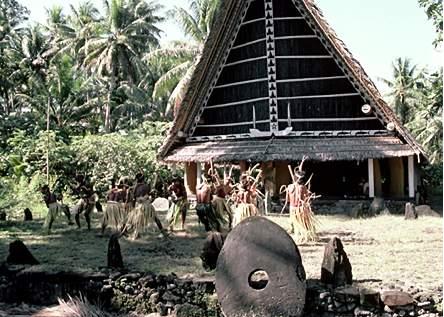
All of Southeast Asia is characterized by hierarchical interactions based on personal ties in which social superiors provide life's necessities to their inferiors in exchange for labor or some other service. Known as patron-client relationships, these traditional ties bind together the rich and the poor in a mutually beneficial pattern.
In Vietnam and Singapore, traditional attitudes have been shaped by a Confucianist philosophy that emphasizes centralized political authority and an administrative system made up of mandarin bureaucrats. Traditional Vietnamese and Singaporean culture rests upon the notion of duties of the lower to the higher: the ruled to the ruler, the son to the father, and the pupil to the teacher. Obligations to superiors are the cement of the Confucian order, very much like that of patron-client relationships. The importance of hierarchy has led many to believe that there are unique Asian values that include harmony, family order, and communitarianism (rather than individualism). This view suggests that there is something in Asian cultures that helps them to avoid the social pathologies of the West, such as high levels of crime, divorce, and teenage hooliganism. Several Southeast Asian leaders have used the notion of Asian values as a rationale for despotism. For example, Myanmar's military dictators have stated that democracy and human rights are not a part of the Burmese culture and that authoritarian rule is consistent with the area's cultural traditions.
Southeast Asian families have traditionally been close and serve as the primary unit of identity. Throughout the region men have held the dominant political positions, and the oldest male is generally considered the leading authority. The women who have held high office in Southeast Asia, such as Corazon Aquino and Gloria Macapagal-Arroyo in the Philippines and Megawati Sukarnoputri in Indonesia, have all been the daughters or wives of famous male political leaders. Despite the patriarchal character of Southeast Asian families, however, women there are generally not considered the "weaker sex."
Southeast Asian art and architecture, much of which has been greatly influenced by India and China, is widely admired. Among the region's most famous historical sites are Thailand's Ban Chiang, with its ancient bronzes and pottery; the Hindu temples of Angkor, in Cambodia; and the Buddhist monuments at Borobudur, Indonesia, and Pagan, Myanmar. Ancient arts such as the Indonesian shadow plays based upon Hindu epics are still popular today, and Southeast Asian cuisine has found appreciative audiences far from its native land.
DEMOGRAPHY: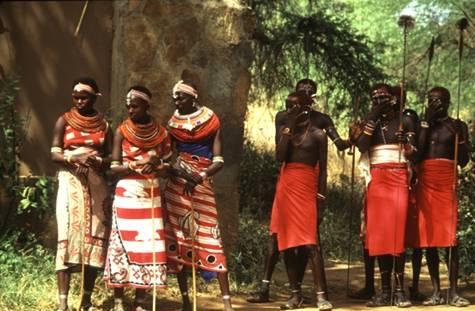

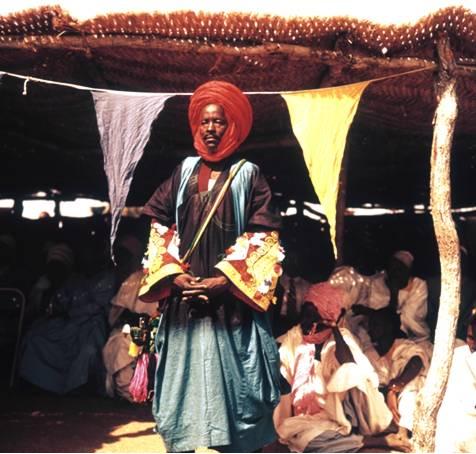
Indonesia, with a population of 206,100,000 (2001 est.), is by far Southeast Asia's most populous nation. Brunei, with some 300,000 citizens (2001 est.), has the fewest people. Singapore, which is essentially a city-state with no agricultural area, is the most densely populated. The entire region is becoming increasingly urbanized, with about 36% of all Southeast Asians living in cities; urban percentages range from 100% in Singapore to just 8% in East Timor. Among the region's largest cities are Manila, Philippines; Jakarta, Indonesia; Bangkok, Thailand; Rangoon (Yangon), Myanmar; and Ho Chi Minh City, Vietnam. More than 15 cities in Southeast Asia have populations exceeding 1 million, and all are growing rapidly.
All Southeast Asian societies practice family planning. In the 1960s, for example, the regional rate of annual population growth was 3.0%, a rate that doubles the population each generation. By 2001 the rate had dropped to 1.6% as a result of governmental programs (most notably in Thailand) designed to reduce the number of births by changing societal values about the appropriate number of children and making birth-control devices available to the public. The lowest rates of annual growth (2001 ests.) are in Thailand (0.8%) and Singapore (0.9%), and the highest are in Laos (2.5%) and the Philippines (2.2%). Average life expectancy for the region is 64 years, ranging from a high of 76 years in Singapore to a low of 47 years in East Timor. An estimated 32% of all Southeast Asians are under the age of 15, with Laos having the youngest population and Singapore the oldest.
EDUCATION AND HEALTH:
Education is considered important throughout the region, and overall literacy is high. Singapore, with more than 90% of its adult population able to read and write, ranks at the top of the scale. Many Southeast Asian universities have achieved international standing.

Excellent health care is available in Southeast Asia's cities, although many rural areas are still underserved. AIDS has recently emerged as the region's most serious health problem. Because of a widespread sexual double standard, many men, whether married or not, visit prostitutes. It is estimated that more than 50% of prostitutes in Southeast Asia are HIV positive. Initially the plague was concentrated among men in the region's major cities. Today, however, the greatest number of persons becoming HIV positive are female, many of them married women who receive the virus from their husbands. Cambodia has the highest rate of HIV, with an estimated 100 persons per day contracting the virus.
ECONOMIC ACTIVITY: 
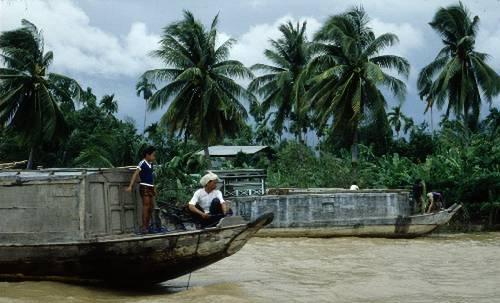

Traditionally, the economy of Southeast Asia has been based on agriculture, with rice being the chief food crop and the leading export. Fish is the most important source of dietary protein, and a wide variety of fruits and vegetables are grown. Natural resources such as petroleum and natural gas from Brunei, Indonesia, and Malaysia; tin from Malaysia; coal from Vietnam; emeralds and other gemstones from Myanmar; and rubber and timber from the region's forests are also important primary exports, although the forests are dwindling rapidly due to overcutting and out-of-control fires during dry years caused by the traditional slash-and-burn agriculture practiced by many of the hill tribes, especially on the island of Borneo. Some Southeast Asian countries have banned commercial logging in an effort to preserve their forest resources.
Since the 1960s, however, much of the region has experienced rapid growth due to the development of export-oriented manufacturingÑespecially Singapore, Indonesia, Malaysia, and Thailand, which had some of the highest rates of economic growth in the world before an economic crisis that began in Thailand in 1997 and spread throughout the region. The crisis showed that the dramatic growth rates in much of the region had masked a situation of imprudent governmental supervision, ineffective political leadership, corruption, a lack of transparency, and undisciplined financial speculation in all of these countries except Singapore. The Philippines, which experienced both less rapid growth and a less stunning decline, has an economic system that is largely controlled by a few wealthy families.
In 2001, just as Southeast Asia began to recover from the crisis of the 1990s, it was hit by a worldwide economic slowdown that reduced the demand for its exports in its chief market, the United States. Singapore remains the regional leader for high-tech exports such as electronics equipment, optical instruments, office machines, and telecommunications apparatus, as well as the region's chief financial center. High-tech goods are also manufactured in Malaysia, Thailand, Indonesia, the Philippines, and elsewhere, along with textiles, garments, footwear, and other export-oriented products.
Both Singapore and Brunei, with its petroleum-based economy, enjoy per capita incomes similar to those of the United States and other industrialized nations. Although the primarily agricultural economies of Laos, Cambodia, and Vietnam are slowly recovering from the devastation of the Vietnam War and the Cambodian genocide and beginning to open to limited free-market reforms, they continue to lag far behind their more-developed neighbors. Myanmar, suffering from decades of military rule and economic mismanagement, remains one of the world's poorest nations. The economy of East Timor was virtually destroyed by the violence that accompanied its overwhelming vote in favor of independence in 1999. Its annual per capita income is estimated at only $320Ñthe region's lowestÑas compared to $27,800 in Singapore, $10,700 in Malaysia, $3,600 in the Philippines, and $1,300 in Laos. Thus, Southeast Asia's economies, like its peoples, are extremely diverse.
| Clear-cut Forest, Malaysia Logging is an important industry in many parts of Asia, particularly in Southeast Asia. However, there is growing concern about the environmental effects of deforestation, caused by clear-cutting trees from large tracts of land. This rain forest was cleared in Sabah state in Malaysia. |
The countries of Southeast Asia are moving increasingly toward cooperative economic ventures and beginning efforts to establish economic links with other nations in Asia (especially Japan and China) in an effort to spur development. All are members of the Association of Southeast Asian Nations (ASEAN), which has as one of its primary goals the establishment of a regional free-trade zone. In 2001, Thailand, Vietnam, and Laos announced plans to build a major highway, including a bridge across the Mekong River, that would link the three countries. That same year, ASEAN began to consider the revival of a century-old dream of building a railroad that would extend through Malaysia, Thailand, Cambodia, and Vietnam to connect Singapore to southern China, with extensions to Myanmar and Laos.
HISTORY:
| José Rizal An advocate of civil equality for Filipinos, political activist José Rizal published a book critical of Spanish colonial rule in the Philippines in 1886, while he was studying in Europe. When he returned to the Philippines, Rizal was exiled to Mindanao. In 1896 Rizal was accused of sedition and executed. He has become a national martyr of the Philippines. |
Little is known about the prehistoric humans who lived in Southeast Asia. Today's hill peoples are thought to be descended from the area's first inhabitantsÑAustroasiatic Mon tribes who migrated southward from China into the Southeast Asian mainland and established commercial links with IndiaÑbut the area is one of the world's great melting pots. Malay peoples (including the Funanese and the Cham) also migrated southward. Later, the Khmer, Vietnamese, Burmese, and other groups also moved south out of China, and Tibetan peoples moved into what is now northern Myanmar. They were followed by the Thai, in about the 13th century, who established their capital at Ayutthia. Muslim seafarers introduced Islam to the islands of Southeast Asia, and Vietnam was heavily influenced by Chinese religion and culture.
In the centuries prior to Western colonization the various empires in what is now Southeast Asia engaged in a constant battle for laborers and land. The most famous of these empires was the Khmer Empire (6th to 15th centuries), which at its height included present-day Cambodia and parts of Thailand, Laos, and Vietnam. The Khmer rulers constructed some of the most extravagant buildings in the world at their capital of Angkor. During the same period, magnificent civilizations also existed in Pagan (in present-day Myanmar), Majapahit (in present-day Indonesia), and Champa (in present-day Vietnam).
THE COLONIAL ERA AND INDEPENDENCE:Prior to the coming of the Portuguese, Dutch, British, French, Spanish, and Americans, Southeast Asia consisted of kingdoms lacking defined boundaries. Western colonization thus began the process of establishing the region's modern nation-states. In 1511 the Portuguese captured Malacca (Melaka), in present-day Malaysia, and dominated the area for a century. The Spanish took over the Philippines in 1571. The Dutch controlled much of Indonesia by the late 16th century, whereas the British moved in more gradually, eventually colonizing what are now Myanmar, Malaysia, Brunei, and Singapore in the 19th century. Similarly, the French gained control of Vietnam, Laos, and Cambodia. Only Thailand remained independent of Western colonial occupation. The boundaries determined by the colonists have essentially lasted until the present day.
Colonial rule differed from place to place, but in all cases territorially stable nation-states were formed. The colonies were exploited for their raw materials and cheap labor. Cash economies were introduced and infrastructure was built, including new ports, railways, and roads. The colonists built hospitals and schools and opened the region to the world economic system. Ironically, the advent of colonialism caused the leaders of Southeast Asia to espouse nationalist goals, including the overthrow of the colonial powers.
World War II provided the opportunity for Southeast Asia to free itself from European colonial domination. When the Japanese occupied Southeast Asia, the colonialists were forced out. Sadly, the indigenous peoples were treated far more cruelly under Japanese occupation than they had been under European rule. When the Japanese were defeated, the British and Americans (who had succeeded the Spanish as rulers of the Philippines in 1898) agreed to a negotiated evolution of their colonies toward independence. The French, on the other hand, attempted to regain their colonies, resulting in the nine-year Indochina War that ended with the defeat of the French in 1954. The Dutch attempt to return to Indonesia also led to a bloody war before the Indonesians gained independence in 1949. Within a few short years, all of the former European colonies had gained independence except for Brunei, which did not end its status as a British colony until 1984. (East Timor, a Portuguese colony which had been forcibly incorporated into Indonesia as its 27th province in 1976, voted for independence in 1999.)
The euphoria of independence was short-lived, however. Authoritarian regimes soon became the norm in much of Southeast Asia. For example, by the 1970s the military ruled Thailand, Cambodia, Myanmar, Indonesia, and South Vietnam. North Vietnam was under Communist rule, and the Philippines was a civilian dictatorship. The Vietnam War, in which China and the Soviet Union backed Communist North Vietnam and the United States and its allies supported South Vietnam, raged from the mid-1950s until 1975. The Vietnam War did much to open Southeast Asia to the outside world and made it a battleground of the cold war, which finally ended with the collapse of the Soviet Union in 1991. Only Malaysia and Singapore (which had separated from it in 1965) had semidemocratic governments before the 1990s, when a wave of democratization swept much of Southeast Asia.
CONTEMPORARY POLITICAL SYSTEMS:Malaysian politics is largely communal in nature, although its government includes elections and several political parties. Although Malays form the largest ethnic group, the Chinese have disproportionate economic influence, as is true in much of Southeast Asia. To cope with its unique ethnic problems, the nation's leaders devised a system that included representatives from all ethnic groups. Singapore is formally a democracy, but in reality the country is dominated by one political party, which controls every aspect of Singaporean society and guides the nation's economy. The price Singapore has paid for its status as Southeast Asia's most prosperous nation is a lack of meaningful popular participation in the affairs of state. The Philippines has had longer experience with democracy than any other nation in the region, although President Ferdinand Marcos proclaimed martial law in 1972 and ruled oppressively until he was ousted by a "people power" revolution in 1986. The contemporary Philippine political system is formally democratic, but in practice it is still largely controlled by a few rich families.
Brunei is an absolute monarchy run by one family and one leader; there are no political parties and no semblance of democracy, but unrest is minimal because the country's rich oil and gas reserves have brought it great wealth. Cambodia, which is still scarred physically and psychologically from the horrific genocidal rule of the Khmer Rouge (1975Ð79), is technically a constitutional monarchy, although its moves toward democracy have been halting, at best. Modern Thailand has been a constitutional monarchy since 1932. Although it spent much of its modern history under military rule, it has been led by democratically elected leaders since 1992. The monarch, though he does not have day-to-day administrative responsibilities, is viewed as the symbol of all that is good in Thailand.
Between independence and 1998, Indonesia had only two presidents, who ruled with the aid of the military. It then began to move toward democracy, but it is riven by ethnic and religious tensions and economic woes that threaten to tear it apart. Vietnam and Laos have had Communist governments since 1975, when the Vietnam War finally ended and that country was reunified. Both still have serious economic problems, and their political systems remain closed despite limited moves towards free-market economies. Myanmar has been under military rule since the early 1960s. When its people demanded democratic government in 1989, the military quashed the uprisings, but it did allow relatively free elections in 1990 in which the opposition won a resounding victory. Shocked by the rebuke, the military voided the elections; arrested, exiled, or executed opposition leaders; and has ruled with an iron fist ever since. Devastated East Timor, which held democratic elections as part of its transition to full independence in May 2002, must build an entire country virtually from scratch.
Thus Southeast Asia remains as politically diverse as it is culturally and economically varied. As it undergoes yet another period of wrenching change, its peoples are working to preserve their ancient traditions and values while improving their standards of living and taking a greater role in their governments.